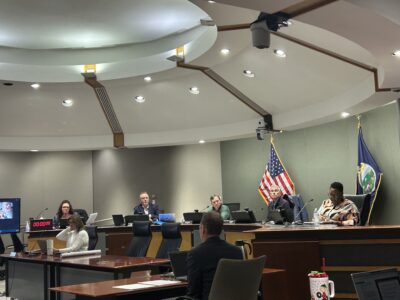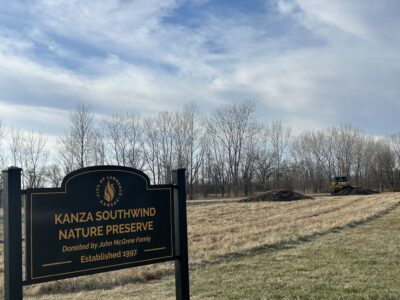City leaders say 3-person fire crews are normal in northeast Kansas, but firefighters say proposed cuts are a ‘looming disaster’

photo by: Bremen Keasey/Journal-World
Protesters hold signs outside of the City Commission meeting room during the commission meeting on Tuesday, July 9, 2024.
Last Tuesday, when dozens of current and former firefighters showed up at Lawrence City Hall, there was no accident, no smoke, nothing on fire. But was there an emergency?
If you ask the firefighters, there certainly was. They were at the Lawrence City Commission meeting because of a budget proposal that would reduce the number of firefighters on duty each day from 39 to 36 and cut the number of people required on a truck from four to three — something that the city’s fire captains are calling a “looming disaster.”
But for City Manager Craig Owens, who put the budget proposal together, this isn’t a five-alarm crisis — rather, he says, it’s a necessary step in addressing other priorities, like improving responses to medical calls and adding new stations.
He and Lawrence-Douglas County Fire Medical Chief Rich Llewellyn also say three-person crews are something that other fire departments in northeast Kansas are already doing. And for a couple of Lawrence’s neighbors, that appears to be true.
• • •
Owens says that reducing the staffing levels per shift on each truck “puts (the city) in line” with most of the other surrounding fire departments. He also says it would allow LDCFM to add another ambulance and medical unit, something he thinks is crucial since medical calls are more common than fire calls.
But the firefighters who are speaking out against the staffing changes say the standards are clear — a truck should always have four people on it.
Some of them have pointed to the National Fire Protection Association standards, specifically the standard known as NFPA 1710, which says that each company of firefighters should be staffed with four members, including a company officer, and that the company officer must remain as part of the company while they’re on a call.
And in their letter to city commissioners that warned of a “looming disaster,” the Lawrence fire captains said the change won’t just make the community less safe, but could also endanger the firefighters.
“A decision to go against these standards and our past practices will cast a long shadow,” the letter said. “It may delay emergency response, increase danger to firefighters and raise insurance premiums.”
At the City Commission meeting on Tuesday, Llewellyn said he was cognizant of those concerns.
He told the commissioners that he was in favor of four-person staffing on fire trucks, and that he thought changing the staffing would “no doubt” impact how much time it takes to respond to emergencies.
But he also acknowledged that it’s not uncommon for departments to have three firefighters on each “apparatus” — fire industry jargon for a fire truck. He said at the meeting that Overland Park has four firefighters per truck if the truck is responding by itself, but that other nearby communities like Lenexa, Olathe and Kansas City, Kan., staff three firefighters per truck.
To confirm what staffing is like in other places, the Journal-World reached out to fire departments in several other Kansas communities. The departments in Lenexa, Wichita and Kansas City, Kan., hadn’t provided details about their staffing as of Friday afternoon, but the Journal-World was able to speak to spokespeople from the Topeka and Olathe departments.
In Topeka, spokesperson Rosie Nichols told the Journal-World that every unit that responds to fire and EMS calls has four people assigned to it, but that crews can still operate with only three of those people.
Nichols said the department strives to meet the operational standards outlined in NFPA 1710, including four-person crews when possible. But there are sometimes staffing limitations, like when firefighters are on leave, that necessitate a three-person crew, she said.
The Olathe Fire Department said it has a similar situation. Captain Mike Hall, the department’s spokesperson, said three of the department’s trucks are staffed with four firefighters, and seven other trucks have three firefighters on board.
• • •
But just because a three-person crew might work sometimes in Topeka or Olathe, that doesn’t mean it will work the same way in Lawrence, said Seamus Albritton, the president of the union that represents Lawrence firefighters, International Association of Fire Fighters Local 1596.
Albritton said he hopes the city doesn’t just look to see what other communities are doing and copy them. He said that in Johnson County communities, for example, there are 40 firehouses close to each other, and the departments have mutual aid agreements in place that can bring a lot more trucks to a fire much quicker. But in Lawrence, there are only five fire stations, and Albritton said a major event can mean all the units respond to that scene.
That Johnson County example centers on something that both the fire department and city staff agree on: the need for more stations. Llewellyn said adding fire stations was “critical” for the department, and Owens said the city has two new stations on its Capital Improvement Plan for next year.
The big question is how to pay for them. Part of Owens’ answer is the property tax rate increase of 3.5 mills in his budget proposal. It’s partly intended to help fund the stations and other improvements to fire and medical infrastructure at a time when the city is facing a slowdown in sales tax collections and a multimillion-dollar budget crunch.
But the other part of the financial picture is the staff cuts. Owens said they were necessary if the department wanted to expand its infrastructure in a sustainable way.
“This allows us to be ready for the expansion of two new stations and reduce our here-and-now (financial) demands,” Owens said.
Not all city commissioners were so sure. Mayor Bart Littlejohn on Tuesday asked city staff to try to project how the mill levy would be affected if there were no staff cuts to LDCFM, and there will certainly be more discussion about the proposal throughout the city budget process, which lasts into September.
However those decisions turn out, Albritton said he hopes city leaders don’t go with lower staffing just because other cities have done so.
“I know there’s conversation about what goes on in other communities, (but) we are not other communities,” Albritton said. “We need every firefighter every minute of every day.”







